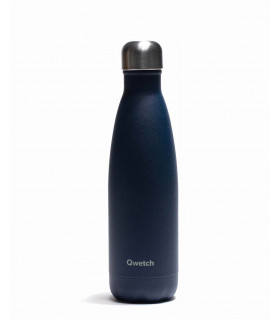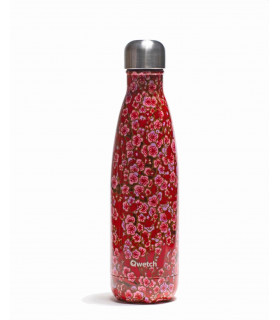Plastic waste: Is recycling just a mirage?
Plastic waste submerges land, rivers, canals and oceans. Recycling plastics is heralded as the silver bullet, though we are struggling to achieve a recycling rate of 2% of plastics in closed circuit and 8% in open circuit. The mirage of recycling plastics veils the only real solution: reducing our use and production of plastic.
The French government has set a target of « 100% of plastics recycled by 2025 » in July 2018. However, the pitfalls of this plan in view of the low possibility of recycling plastic are clear. Moreover, this type of message clears society of the use of plastic and the mountains of plastic packaging. Making us believe that this waste will have no environmental impact, because it is recycled. Is perfect recycling in a closed circuit (infinite reuse of material) really possible? Isn't announcing a massive recycling of plastic, rather not a way of validating our consumerist system? Wouldn't it be wiser to turn to other more respectful and truly recyclable materials to condition our products (such as glass, steel and cardboard)?
How did we get there?
Plastic was born in the early 1960s, following the discovery of petrochemicals. Nobel prizes were even awarded in 1963 for the development of catalysts allowing the polymerization of polyethylene and polypropylene.
The plastic era, as our last 50 years are often called, is due to continued indifference on all sides. The economic development enabled by plastic has been given priority to flora and fauna. Plastic has thus spread in all sectors of activity for ease and for a low economic cost without taking ecological repercussions into account.
These petroleum derivatives are now widespread in food and delivery packaging of meals. Given their massive use, these plastics are problematic today. The mass of discarded plastic is such that even China has stopped trying to be the world's garbage bin and closed its borders to overseas plastic waste. Today, recycling does not seem to be able to be the answer to the situation and here is why:
Plastics production still on the rise
Plastic has undoubtedly enabled many areas of our daily activity to progress: construction, automotive, electronics, aeronautics and first and foremost food. Inexpensive packaging, at the time it offered a real breakthrough in food safety. Protecting against contaminations (chemical or bacterial), preserving the quality and making it possible to more easily trace products. Plastic initially presented only beneficial effects. All of this, through its protection, reducing food loss and waste around the world
Today the abuses of its use are criticized from all sides. Over-packaging, excessive use, explosion of home and take-out meal deliveries, plastic is used for convenience and above all for its low financial cost. Current plastic production is on track to double by 2040, when we already produce 300 million tons of plastic each year globally (60 in Europe, see graph).

40% of these plastics go to food packaging (trays, yoghurt pots, water bottles, soda bottles, etc.) and end up in the trash only after a few hours of use. They will then take more than 400 years to decompose. Moreover, after several tens of years they degrade to nanoplastics. This will give the possibility for plastics to be able to cross our human tissue barriers and stick to our organs (liver, heart, lungs). We still do not recognize the consequences today, but it is feared that they should be serious (resurgence of cancers and impotence are announced).
Where does our plastic waste end up?
Nanoplastics have also been seen in bottled water, salt, fish and seafood, and honey! These discoveries have led to a major mobilization to reduce and eradicate the continents of plastic floating in the oceans. However, the visibility of plastics in the oceans obscures the sad truth: it only represents 8% of the discarded plastics. The vast majority (over 80%) are buried in landfills or are mindlessly thrown into the wild.
Each year in Europe we individually throw away the equivalent of our weight in plastic. Taking all of the plastic used and discarded, then divided by the population, the global average of plastic consumed per person is 40kg. It is 63kg in Europe and even 68kg in France! An aberration when we want to move towards a circular economy, virtuous for the environment and above all sustainable.
1. Landfill and plastic waste disposal
25% of this lastic waste mass is divided between incineration and recycling. Between 35% and 50% end up in an uncontrolled manner in nature and between 25 and 40% end up in landfill or in our textiles (fleeces, sports shirts, backpacks). These will eventually end up in nature (with each washing part that will come off and end up in waterways) or in landfill. We are just delaying the deadline, but more than three-quarters of the plastics used will end up in our lands, drinking waterways and our oceans.

2. Incineration of plastic waste
Although there are no strict measures at the national or international level, according to the various reports, the incineration rate is estimated at 10-15%. Plastic (a material derived from petroleum) releases a lot of energy during incineration and is beneficial in this sense. However, this plastic incineration also releases many volatile chemicals (Bisphenol A) and toxic burnt materials. These will be stored without perspectives.
3. Recycling of plastic waste
Last of this list, recycling is divided into two sub-categories, that where the plastic is recycled in open circuit and that where it is recycled in closed circuit:
Open-circuit plastic recycling defines recycled plastics, which once recycled cannot be recycled a second time (textiles). It also includes those that require injection of new plastic to make a new product. Calling it single-use recycling is therefore more relevant than actually calling it recycling.
Closed-loop plastic recycling is the unrealizable dream of being able to reuse the same plastic an unlimited number of times without affecting the quality of the product recreated afterwards. This concerns less than 2% of plastics due to the large number of plastic fibers, colors and polymers used.
Is plastic recycling a myth?
The desire to endlessly recycle plastic will require a change in operation and paradigm. To recycle in a closed circuit, you will need:
- Collect plastic
- Sort plastic by polymer
- Decontaminate plastic
- Repolymerize the plastic (due to the loss of quality during the recycling process)
Collecting plastic will require energy and several constraints. There needs to be a strong national network so that plastic does not have to travel hundreds of kilometers constantly to reach the sorting center.
Sorting plastic by polymer will also force us to reduce the types of plastics used. Today a classification system sorts them into 7 categories, but there are many more:
- Polyethylene terephthalate (PET) (most used plastic for soda bottles and food packaging and the rare one that can be used in closed recycling)
- High density polyethylene (HDPE) (plastic used for bottles and flasks of household products)
- Polyvinyl Chloride (PVC) (used in supermarkets to package cheese and meat. This plastic can only be recycled a little and releases dioxins and carcinogens (BPA))
- Low density polyethylene (LDPE) (mainly used for plastic bags and packaging, complicated to recycle because very thin)
- Polypropylene (PP) (used everywhere, it can only be recycled several times before having to be incinerated)
- Polystyrene (PS) (we no longer present it, although recyclable, but not infinitely, it must be deposited in a specialized sorting center)
- The others (unfortunately the list is long and very often plastic alloys are made, making recycling close to impossible)
To recycle, it will therefore be necessary to rationalize the types of plastics used to allow sorting centers and recycling plants to optimize their specializations. The plastics collected can then be sorted more quickly and the whole can then aim to be recycled efficiently. There is therefore still a long way to go and achieving zero waste is unfortunately not yet on the agenda at this stage.
While recycling should be encouraged because we already have a lot of plastic in existence, it is easier to understand why we cannot recycle the way we are supposed to. It is only PET that would allow recycling in a closed circuit. Today only 50% of PET bottles are recycled and only 10% of plastic bottles on the market are made from recycled plastic.
The reasons for it relate to health but above all economic. Recycled plastic now costs more than new plastic, due to all the steps prior to the recycling process. Collection, sorting, cleaning and decontamination have a cost. It is therefore less expensive to produce new packaging and to hide behind health arguments.
Striving towards a responsible, ecological and above all respectful consumption is the only way to eliminate the problem. Blaming the consumer in his consumption is not the solution. Clear it of environmental responsibilities by promising the wonders of recycling, either. We must stop producing waste and opt for ecological materials and biodegradable alternatives such as glass, steel and natural fabrics. Plastic should not be used where no other solution is possible and only the one whose treatment and recycling we know from A to Z.












